Feeding your bearded dragon takes more than just offering a few random bugs. To help them grow strong and stay healthy, you need to provide a balanced insect-based diet. That’s why many owners ask: what insects can bearded dragons eat, and how can they tell which ones are truly safe?
The truth might surprise you. Some insects are loaded with essential nutrients like calcium and protein. Others, even popular ones, can cause problems like obesity or digestive issues if fed too often.
This updated 2025 expert guide breaks it all down. You’ll learn exactly what insects can bearded dragons eat, how often to feed them, and which bugs to skip. We’ll also uncover one unexpected insect that boosts calcium naturally—and expose a commonly used feeder that might be harming your beardie’s health.
Let’s explore the complete list and help you make smart choices for your dragon’s daily meals.
Why Insects Matter in a Bearded Dragon’s Diet
Insects play a crucial role in a bearded dragon’s overall health and development. They provide essential nutrients like protein, calcium, and moisture—especially important during growth stages. Understanding why insects matter helps you build a diet that supports energy, bone strength, and long-term wellness.
Natural Feeding Behavior in the Wild
In the wild, bearded dragons are opportunistic hunters. They actively search for moving prey like insects, small rodents, and even smaller reptiles. Bugs make up a large part of their diet—especially during their juvenile stage when protein demand is highest.
They rely heavily on movement to locate food. This is why live insects are so stimulating and essential in captivity. Hunting keeps them physically and mentally active, mimicking their wild instincts. It also prevents boredom and promotes exercise, which is key in enclosed environments.
Wild bearded dragons consume a wide variety of insects, ensuring a nutrient-rich intake. In captivity, mimicking this variety helps replicate the same nutritional benefits. Offering different insects, rather than sticking to one or two, creates a healthier, more enriching feeding routine for your beardie.
Key Nutrients Found in Insects Bearded Dragons Can Eat
Bearded dragons need a balanced mix of nutrients to thrive. Protein is vital for muscle development and growth—especially in hatchlings and juveniles. Fat provides energy but must be controlled to avoid obesity in adults.
Calcium is one of the most important nutrients. It supports bone development and helps prevent metabolic bone disease, a common but serious condition in reptiles. Insects low in calcium or high in phosphorus can interfere with calcium absorption and harm your dragon’s health.
Hydration is often overlooked. Many insects, like hornworms or silkworms, have high moisture content that supports hydration. This is especially helpful when dragons are reluctant to drink water directly.
Feeding a variety of insects ensures a balanced intake of these core nutrients. That’s why understanding the nutritional profile of each bug matters more than simply feeding what’s available.
What Makes an Insect Safe or Unsafe?
Not all insects are safe for your bearded dragon. Some contain dangerous levels of fat or phosphorus, while others carry parasites or pesticide residues. Wild-caught insects, for example, may look harmless—but they often introduce harmful bacteria or toxins that can make your dragon sick.
A safe insect comes from clean, controlled environments and offers a strong nutritional profile. Look for bugs raised specifically as feeder insects. They should be nutrient-dense, free of chemicals, and easy to digest. The ideal bug has a healthy calcium-to-phosphorus ratio (close to 2:1) and is small enough to avoid choking or impaction.
Hard-bodied insects with tough exoskeletons—like adult beetles—can cause digestion problems, especially in young dragons. Bugs high in fat, such as waxworms and butterworms, work best as occasional treats rather than daily food.
By choosing insects that are clean, safe, and nutritionally balanced, you can avoid common health issues and give your dragon a diet that supports strength, energy, and long-term wellness.
What Insects Can Bearded Dragons Eat? (The Safe List)
Not all bugs are created equal when it comes to your bearded dragon’s health. Some insects are packed with essential nutrients, while others should only be fed occasionally—or avoided altogether. In this section, you’ll discover what insects bearded dragons can eat safely, along with the key benefits of each.
| Insect | Protein (%) | Fat (%) | Calcium (mg/kg) | Phosphorus (mg/kg) | Safe for Babies? | Staple or Treat? |
| Dubia Roaches | 21.4 | 3.1 | 700 | 2600 | Yes | Staple |
| Crickets | 15.4 | 3.3 | 275 | 2520 | Yes (with care) | Staple |
| Black Soldier Fly Larvae | 17.5 | 14.0 | 9340 | 3560 | Yes | Staple |
| Hornworms | 9.0 | 3.07 | 464 | 1394 | Yes | Staple (with others) |
| Silkworms | 9.3 | 1.1 | 177 | 2370 | Yes | Occasional |
| Butterworms | 15.5 | 29.4 | 125 | 2250 | No | Treat |
| Superworms | 19.7 | 17.7 | 177 | 2370 | No | Treat |
| Mealworms | 18.7 | 13.4 | 169 | 2950 | No | Occasional |
Dubia Roaches – The Gold Standard
Dubia roaches are often recommended as the top feeder insect for bearded dragons—and for good reason. They offer a great balance of protein and fat, supporting steady energy without contributing to obesity. Their calcium-to-phosphorus ratio is safer than many other insects, making them a top choice for strong bones.
They’re also clean, quiet, and easy to raise at home. Since they don’t climb smooth surfaces or fly, they’re simple to contain. Dubias are gentle on the digestive system and suitable for dragons of all ages, including babies. If you want a reliable everyday insect, dubia roaches are hard to beat.
Crickets – What Insects Can Bearded Dragons Eat Besides Roaches?
Crickets are easy to find and commonly used by new and experienced reptile owners alike. They contain enough protein to support growth and are usually accepted well by most dragons. However, they don’t offer much calcium and have a higher phosphorus content, which can become an issue over time.
Crickets can also be noisy, smelly, and short-lived. Poorly sourced crickets may carry parasites, so always buy from trusted suppliers. While they can be a part of your dragon’s diet, don’t rely on them as the sole feeder.
Black Soldier Fly Larvae – A Calcium Powerhouse
Black soldier fly larvae stand out for their naturally high calcium levels. This makes them a great addition to your dragon’s diet, especially if you want to reduce the need for powdered supplements. They are small, soft, and easy to digest, which makes them ideal for young or recovering reptiles.
These larvae are also clean and don’t require feeding before offering them to your dragon. They can be fed often and paired with other insects for variety. Thanks to their nutrient content, they’re one of the healthiest feeders you can use.
Hornworms – What Insects Can Bearded Dragons Eat for Hydration?
Hornworms are best known for their high moisture content. They help with hydration, especially during warmer months or when your dragon doesn’t drink much water. These worms grow rapidly and can become large in just a few days.
Their soft bodies make them easy to digest, which is helpful for younger dragons. However, they don’t provide much protein or calcium, so you should not rely on them alone. Use them as a hydration booster along with more nutrient-dense bugs.
Silkworms – Gentle but Low in Protein
Silkworms are a great option for sensitive or picky eaters. They are soft-bodied and easy on the digestive system, making them a safe choice for dragons of any age. They also contain a mild amount of calcium.
Despite their benefits, silkworms are lower in protein and not as widely available. Since they’re also more expensive than most feeders, they’re best used occasionally. If you find a reliable source, they can be a valuable addition to your feeding rotation.
Butterworms – What Insects Can Bearded Dragons Eat as a Treat Only?
Butterworms are rich in fat and flavor, which makes them especially appealing to bearded dragons. They’re often used as a reward or appetite booster for picky eaters. While they do provide some protein, their fat content is too high for regular feeding.
These worms are better reserved for occasional use. Offering them once a week or less helps prevent weight gain. Because of their soft texture, they’re easy to digest—but only in small amounts.
Superworms – High Fat and Aggressive
Superworms are a favorite for their size, movement, and crunch—but they aren’t without risk. They contain a fair amount of protein but also a high level of fat. Their hard outer shell can be tough for younger dragons to digest, and they may bite if handled carelessly.
Adult dragons usually enjoy them, but you should supervise feeding. Always dust superworms with calcium before offering them. Because of their fat content, they’re best used sparingly—more like a treat than a daily staple.
Mealworms – What Insects Can Bearded Dragons Eat with Caution?
Mealworms are easy to purchase and store, making them a convenient option. They have a solid protein profile and are often offered to adult dragons. However, their tough chitin shell can cause digestive issues, particularly in baby or juvenile reptiles.
Mealworms should be fed in moderation and only to mature dragons. They’re not suitable for daily feeding due to their poor calcium balance and difficult digestibility. Always offer hydration alongside mealworms to help prevent impaction.
Waxworms – Obesity Risk, Use Sparingly
Waxworms are soft, fatty, and highly palatable—making them an irresistible snack for many bearded dragons. Unfortunately, their high fat levels can quickly lead to weight issues if fed too often.
Use waxworms as a rare treat or when your dragon needs encouragement to eat. Avoid offering them to overweight or sedentary reptiles. A couple of waxworms once a week is plenty, and they should always be part of a balanced, varied diet.
Insects to Avoid Feeding Your Bearded Dragon
Not every insect is safe for your bearded dragon. Some bugs may seem harmless but can carry parasites, toxins, or poor nutritional balance that puts your pet’s health at risk. In this section, we’ll cover the insects you should always avoid feeding your dragon—and explain why they can be dangerous.
Learn more about feeding beetles safely and which types to avoid.
Wild-Caught Bugs (Parasites & Pesticides)
It may be tempting to catch bugs from your backyard and offer them to your bearded dragon, but this is a dangerous choice. Wild insects often carry parasites, bacteria, or fungal spores that can make your dragon sick. These bugs may also have been exposed to pesticides, fertilizers, or roadside chemicals, which are toxic even in small amounts.
Unlike store-bought feeder insects, wild bugs are not raised in clean, controlled environments. You can’t be sure what they’ve eaten or where they’ve been. Even one contaminated insect could lead to digestive problems, infections, or long-term organ damage.
Always choose insects from trusted breeders or reptile supply stores. Commercially raised bugs are gut-loaded, parasite-free, and much safer for your dragon to eat. No matter how healthy wild bugs look, it’s never worth the risk.
Fireflies and Lightning Bugs (Toxic!)
Fireflies and lightning bugs are extremely dangerous for bearded dragons. These insects contain a toxin called lucibufagins, which is meant to deter predators in the wild. Even one firefly can be deadly if eaten by a reptile.
Lucibufagins attack the heart and nervous system. Reactions can happen within minutes, and symptoms include seizures, vomiting, or sudden collapse. Sadly, in many cases, there is no recovery.
Because of their glow and slow movement, fireflies might attract your dragon’s attention. Keep windows closed at night and avoid outdoor feedings during firefly season. Educate other family members or children not to collect and feed glowing bugs to your pet.
If your bearded dragon accidentally eats a firefly, contact a reptile veterinarian immediately. Prevention is key—always double-check feeders to ensure no toxic insects are mixed in.
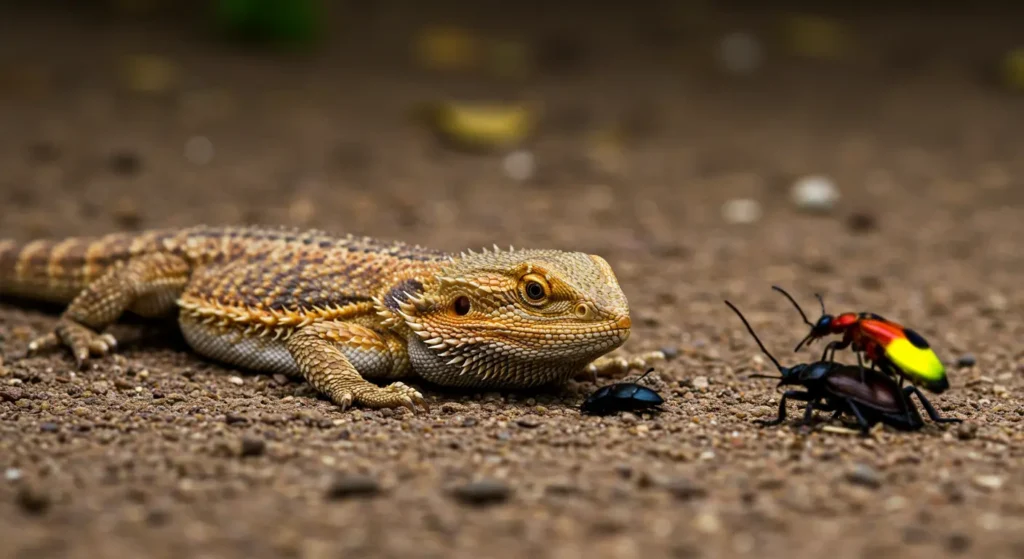
Beetles with Hard Shells
Some beetles may seem like acceptable feeders, especially if they’re small and slow. But many beetles have thick exoskeletons made of chitin—a tough, indigestible material. These shells can cause digestive blockages, especially in young or small dragons.
While certain beetles, like darkling beetles from superworms, may be safe in moderation, most wild beetles should be avoided. Not only are they hard to chew and digest, but some beetles also release noxious chemicals as a defense. These secretions can irritate your dragon’s mouth or digestive tract.
In addition, beetles don’t offer much nutritional value. They’re often high in indigestible fiber and low in essential nutrients. Stick with soft-bodied insects raised specifically for reptiles.
If you’re unsure whether a beetle is safe, err on the side of caution and avoid feeding it altogether.
Unsafe Worms (e.g., Earthworms from Soil)
Worms might look like a natural food source, but not all are safe for bearded dragons. Earthworms, in particular, are often collected from moist soil or bait containers. These environments can expose them to bacteria, parasites, and chemical contaminants.
Dragons may enjoy the texture of worms, but wild or bait-sourced worms are unpredictable. Some carry harmful microbes or pesticides absorbed from soil. Others may be too large or too slimy, causing digestion issues or vomiting.
Even store-bought bait worms should be treated with caution unless they’re specifically labeled as reptile-safe. Their diet and environment are rarely regulated for pet safety.
If you want to include worms in your dragon’s diet, choose ones from trusted reptile suppliers. Phoenix worms, silkworms, and hornworms are safer alternatives that offer better nutrition without the health risks.
Age Matters – Feeding Insects by Life Stage
Bearded dragons have different nutritional needs at each stage of life. The type, size, and amount of insects you feed should match their age and growth rate. In this section, we’ll break down how to safely feed hatchlings, juveniles, and adult dragons based on their specific dietary requirements.
What Insects Can Baby Bearded Dragons Eat Safely? (0–5 Months)
Baby bearded dragons grow quickly and need a protein-rich diet to support that growth. At this stage, insects should make up about 80% of their daily food intake. Feed small, soft-bodied bugs like pinhead crickets, small dubia roaches, and black soldier fly larvae.
Babies require frequent feeding. Offer insects 3 to 5 times per day, letting them eat for 10–15 minutes at each session. Always use insects smaller than the space between their eyes to prevent choking or impaction.
Dust all insects with calcium powder once per day and provide multivitamins two to three times a week. Hydration is also crucial—mist babies daily or offer water drops from a syringe.
Avoid hard-shelled insects and fatty treats like waxworms during this stage. Focus on high-calcium, digestible feeders to help your dragon develop strong bones and muscles.
What Insects Can Juvenile Bearded Dragons Eat Daily? (6–12 Months)
Juvenile dragons are still growing but begin transitioning to a more balanced diet. At this stage, aim for a 50/50 split between insects and vegetables. Offer insects twice per day, with a variety of protein sources like dubia roaches, silkworms, and hornworms.
Continue choosing insects that match their head size to prevent impaction. You can now introduce superworms or small mealworms occasionally—but not daily.
Calcium remains important, so continue dusting insects with a calcium supplement five days a week. Offer multivitamins once or twice a week. Encourage more greens during this period to prepare them for their adult diet.
Watch for signs of overfeeding, such as bloating or sluggish behavior. Juvenile dragons still have strong appetites, but portion control becomes more important as they age.
What Insects Can Adult Bearded Dragons Eat Occasionally? (12+ Months)
Adult dragons have slower metabolisms and need less protein than younger ones. Shift their diet to about 80% vegetables and 20% insects. Feed insects once a day or every other day, depending on their weight and activity level.
Stick with low-fat, high-calcium insects like dubia roaches, black soldier fly larvae, and hornworms. You can offer superworms or waxworms as rare treats, but avoid making them a regular part of the diet.
Calcium supplementation should continue two to three times a week. Multivitamins can be given once a week. Provide plenty of fresh greens daily and rotate vegetables to keep their interest.
Avoid overfeeding adults, as obesity is a common issue in captivity. Monitor weight monthly and adjust feeding amounts as needed. A well-balanced routine helps your adult dragon stay healthy and active long-term.
Feeding Frequency Table by Age
| Age Range | Insect Ratio | Feedings per Day | Calcium Dusting Frequency | Veggie Focus |
| 0–5 months (Baby) | 80% insects | 3–5 | Daily | 20% |
| 6–12 months (Juvenile) | 50% insects | 2 | 5x/week | 50% |
| 12+ months (Adult) | 20% insects | 1 or every other day | 2–3x/week | 80% |
How to Feed What Insects Can Bearded Dragons Eat the Right Way
Feeding your bearded dragon isn’t just about what you serve—it’s also about how you serve it. Proper feeding techniques can improve digestion, boost nutrient absorption, and prevent common health issues. In this section, you’ll learn practical tips to make every meal safer and more effective for your beardie.
Gut-Loading Insects Before Feeding
Gut-loading means feeding your insects nutritious foods before offering them to your bearded dragon. This process helps transfer more vitamins and minerals into your dragon’s diet. Think of it as boosting the value of each bite.
Use leafy greens, carrots, squash, and calcium-rich vegetables like mustard greens to gut-load your insects. Avoid spinach or iceberg lettuce, as they provide little nutritional benefit. Feed the insects 12 to 24 hours before giving them to your dragon.
You can also buy commercial gut-load formulas if you’re short on time. These mixes are specifically designed to enhance insect nutrition. Gut-loading works best with feeders like crickets, dubia roaches, and black soldier fly larvae.
Never feed insects that haven’t eaten well themselves. Empty insects offer almost no benefit and can lead to vitamin deficiencies over time. Gut-loading is a simple step with a big impact on your dragon’s health.
Dusting with Calcium and Vitamin Supplements
Bearded dragons in captivity often don’t get enough calcium or vitamin D3 from their diet alone. Dusting insects with supplements helps fill that gap and prevents serious health issues like metabolic bone disease.
Use a calcium powder with D3 for indoor dragons, and one without D3 if your dragon regularly gets unfiltered sunlight. Lightly dust the insects by placing them in a small bag or container with the supplement and shaking gently.
Calcium should be added to meals about 3–5 times a week, depending on your dragon’s age. Younger dragons need it more often. Add a reptile-safe multivitamin once or twice a week as well.
Avoid over-supplementing, as too much can lead to toxicity. Keep a schedule and rotate between calcium and multivitamins to maintain balance. This small habit greatly improves your dragon’s bone strength and immune health.
Safe Feeding Methods (Avoid Impaction)
Impaction occurs when your bearded dragon swallows something it can’t digest or pass. This can lead to serious health problems and even death if left untreated. Fortunately, safe feeding methods help prevent this.
Always choose insect sizes that are no longer than the space between your dragon’s eyes. Avoid large, hard-shelled insects like beetles or full-grown mealworms for young dragons. These are difficult to digest and can get stuck in the digestive tract.
Use feeding bowls with smooth edges to reduce the chance of substrate ingestion. Never feed insects directly on loose substrates like sand or wood chips. For extra safety, offer bugs in a separate feeding enclosure.
Make sure your dragon stays hydrated, too. Water helps soften food and move it through the digestive system. Combined with proper food sizing and substrate control, this significantly lowers impaction risks.
Watch for These Warning Signs in Your Dragon
Even with proper care, bearded dragons can show signs that something’s wrong. Recognizing these early helps you act quickly and avoid serious illness.
Watch for lethargy, loss of appetite, bloating, or difficulty passing waste. These may signal impaction or digestive problems. Weight loss, shaky legs, or soft jawbones could point to calcium deficiency or metabolic bone disease.
Pay attention to unusual behaviors. If your dragon avoids food it usually loves, spends too much time hiding, or seems weak, it’s time to investigate. Small changes often hint at bigger health issues.
Track your dragon’s weight and bowel habits weekly. Regular health checks make it easier to spot problems early. If you notice multiple warning signs, consult a reptile vet as soon as possible.
Quick response and preventive care go a long way in keeping your bearded dragon healthy and active.
FAQs – What Insects Can Bearded Dragons Eat?
Can bearded dragons eat insects every day?
Yes, bearded dragons can eat insects every day—especially when they’re young. Baby and juvenile dragons need high amounts of protein to grow, so they rely heavily on insects as their primary food source. Most should be fed insects 3 to 5 times a day during their early months.
As they mature, however, their need for daily insects decreases. Adult dragons should eat more vegetables and fewer bugs. In fact, feeding adult dragons insects every day can lead to obesity or excess phosphorus if you’re not careful.
If your dragon is a picky eater or underweight, a daily insect meal may still be appropriate—but portion control is key. Make sure to use gut-loaded, calcium-dusted bugs, and always offer appropriate-sized feeders. The right balance depends on your dragon’s age, health, and activity level.
What is the best insect for daily feeding?
The best insect for daily feeding is the dubia roach. It’s high in protein, low in fat, and has a relatively balanced calcium-to-phosphorus ratio. Dubia roaches are also easy to digest, which makes them suitable for bearded dragons of all ages.
Unlike crickets, dubias don’t smell, make noise, or jump away. They’re also less likely to carry parasites, especially when raised in clean environments. Another excellent option is the black soldier fly larva. These small, soft-bodied insects are rich in calcium and very safe to feed regularly.
Variety is important, so it’s a good idea to rotate dubias with other safe staples like hornworms or silkworms. Avoid high-fat feeders like waxworms as a daily option—they’re better used as treats.
Choosing high-quality insects improves your dragon’s digestion, bone health, and overall energy levels.
Are superworms safe for young beardies?
Superworms are not safe for baby bearded dragons. They have tough exoskeletons and can be hard to digest, increasing the risk of gut impaction. They’re also quite large and aggressive, which makes them difficult for hatchlings or timid dragons to handle.
Juvenile dragons (6–12 months old) may tolerate small superworms in moderation if they’re active and have strong digestion. Still, it’s better to wait until your dragon is at least 5–6 inches long before offering one. Even then, feed superworms sparingly.
For young dragons, stick with softer insects like black soldier fly larvae, pinhead crickets, or small dubia roaches. These options are easier on the gut and provide better nutrition for growth.
Once your dragon matures, superworms can be added occasionally as a treat, but never as a daily staple.
How many insects should I feed per day?
The number of insects your bearded dragon needs depends mostly on age. Baby dragons (0–5 months) eat the most—often 30 to 50 small insects per day, split across 3 to 5 meals. Let them eat for 10–15 minutes each session.
Juvenile dragons (6–12 months) usually eat 20 to 30 insects per day. Two feeding sessions are enough, along with increased amounts of vegetables.
Adult dragons (12+ months) don’t need as many insects. Offer 5 to 10 insects per feeding, just once per day—or even every other day, depending on their weight and activity level.
Always consider the size of the insect and your dragon’s current health. Only feed bugs that are smaller than the space between their eyes. Overfeeding can lead to obesity and organ stress, while underfeeding may stunt growth in young dragons.
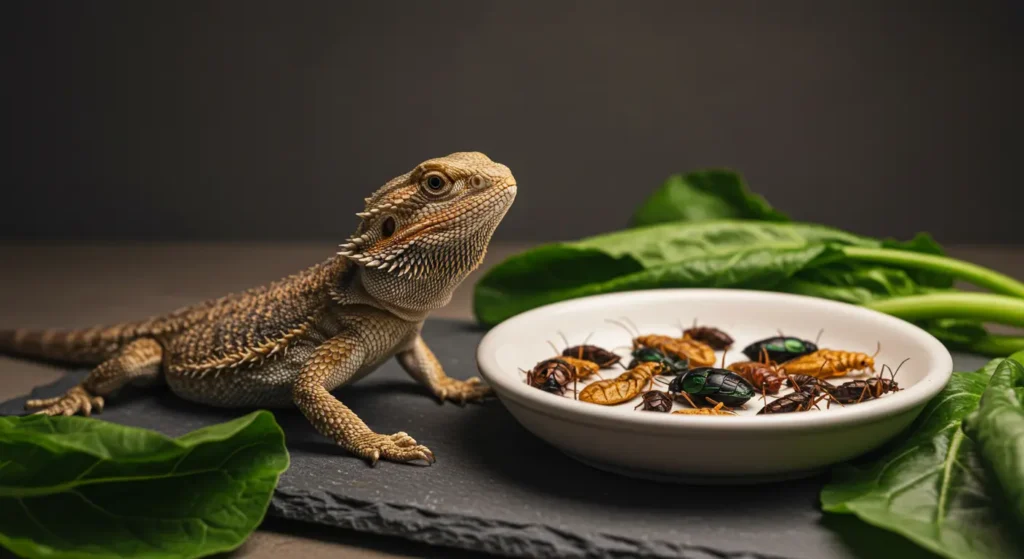
Conclusion
If you’ve ever wondered what insects can bearded dragons eat, now you have a clear, confident answer. From highly nutritious staples like dubia roaches and black soldier fly larvae to hydration boosters like hornworms, the right insect choices can help your beardie thrive at every life stage.
But just as important as knowing what to feed is knowing what to avoid. High-fat insects like waxworms and butterworms should be limited to occasional treats. Dangerous options like wild-caught bugs and fireflies should never be on the menu.

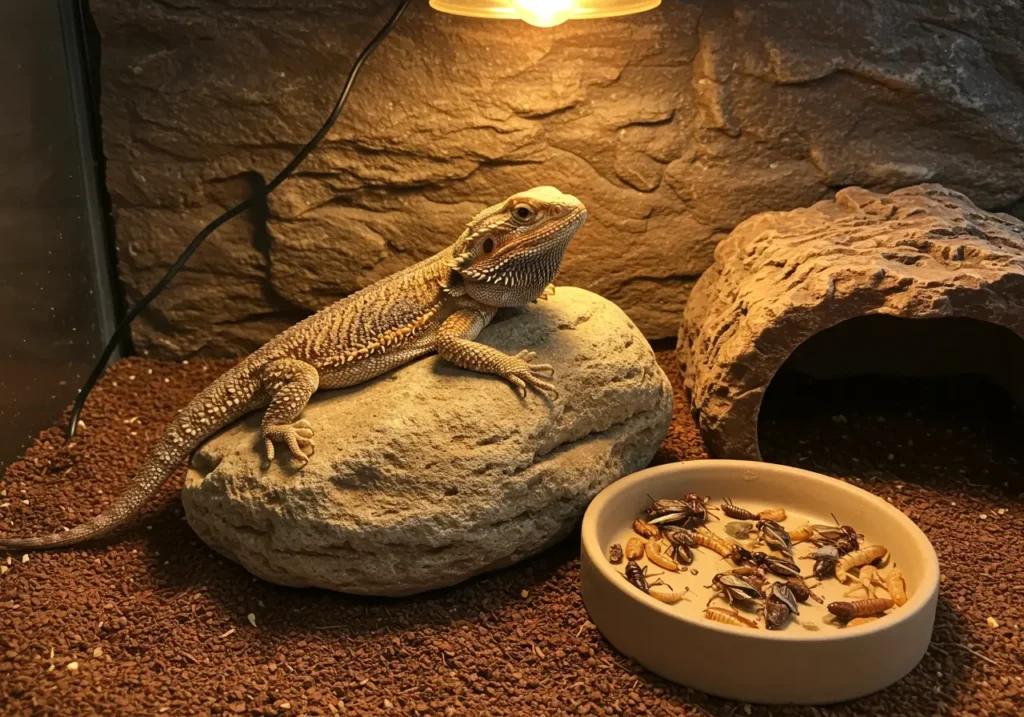
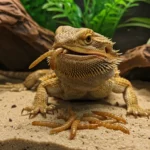
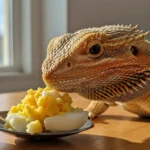
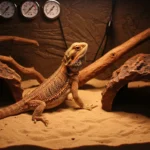
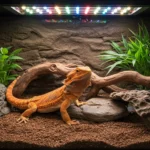
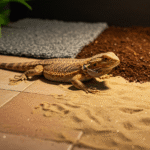
5 thoughts on “The Ultimate List: What Insects Can Bearded Dragons Eat Safely?”